Can Northampton's 'dying' High Street be saved?
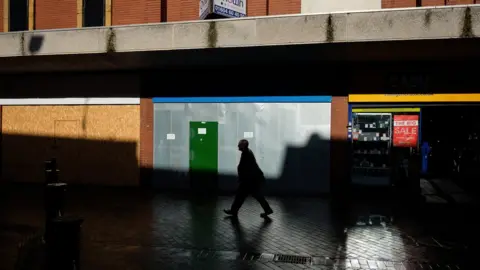 Leon Neal/Getty
Leon Neal/GettyThe number of boarded-up shop fronts in towns the length and breadth of England is symbolic of the country's growing High Street crisis. Perhaps nowhere quite encapsulates this as much as Northampton, which in the past five years has lost three major department stores with the future of a fourth uncertain.
In recent years countless big name chains like Woolworths, BHS, Toys R Us and Comet have faced the administrators and folded. Others have clung on, saved by rescue deals or by swapping their bricks and mortar businesses for the digital marketplace.
That in itself appears to be a Catch-22. Only last month, MPs warned that British High Streets were "in danger of becoming ghost towns" as consumers flock to internet retailers.
In towns like Northampton, there has been a slow drip of shop closures. And conspicuous by their absence are the shoppers that once used to crowd into its market square.
"The place used to be packed," says fruit and veg market trader, Anne Andreoli. "It used to be rammed with customers and you'd be serving non-stop, all day.
"At one stage there was a 100-year waiting list to get a stall. Now you can take your pick. The change has been humongous."
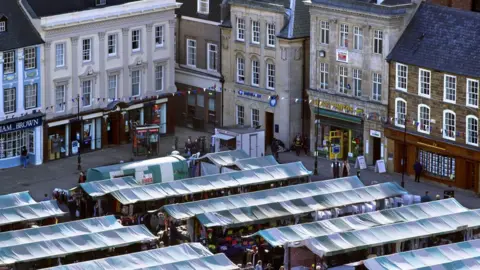 Photofusion/Getty
Photofusion/GettyThe square is one of Britain's largest and dates back to 1235. For centuries it was the centre of the town's bustling market trade.
"This used to be a good living but I struggle to cover the stall rent now," says Lesley McDonald, who has run an underwear stall for 28 years.
She and her husband used to work on it together, but he is now a window cleaner - an income they rely on.
"There's just no trade. The youngsters shop online and since we lost M&S we've seen a big decline in older customers," she says.
"I get here at six in the morning and often I've not had a single customer by 10 but I can't just walk away. I keep hoping it will go back to how it was but I don't think it will."

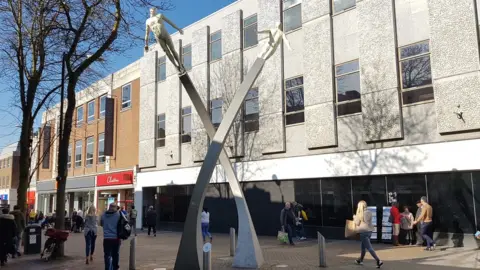
Marks and Spencer, like many others, was lured away to the £140m Rushden Lakes retail park, which opened 15 miles east of Northampton in 2017.
The retailer's move prompted local celebrity and broadcaster the Reverend Richard Coles to describe the town centre as "decaying".
On Abington Street - Northampton's main thoroughfare - about a third of units are vacant and many of the entrances now occupied by homeless people in tents.
The M&S shop has been empty since August and is now boarded up. BHS, which closed in 2016, has only recently been occupied by a factory outlet store, while House of Fraser closed in 2014.
Now, the future of the nearby Debenhams branch is uncertain. It has agreed a £200m refinancing lifeline with lenders but said it would continue with plans to cut the number of its stores.

What's happening on the UK High Street?
Each year, more shops close than open in the UK and the gap is getting wider.
According to figures from PWC and the Local Data Company, 2,692 shops shut in the first half of 2018 - about 14 per day - while 1,569 opened, a net loss of 1,123.
That compared with a net loss of 222 in the same six months of 2017. Clothes shops and pubs were the biggest casualties.
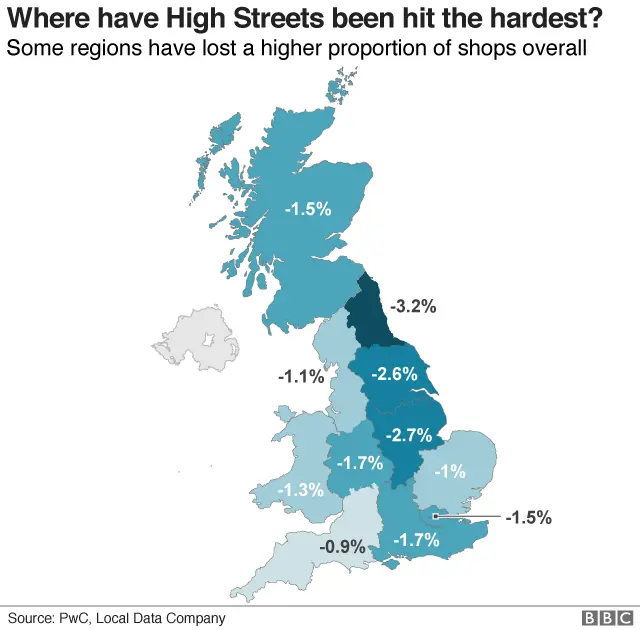

In January 2008 the internet accounted for 5p in every £1 of retail sales. By August 2018, it was 18p in every pound.
In 2018, 43 retailers with multiple stores either closed or went into administration, affecting 2,594 shops and 46,000 jobs according to the Centre for Retail Research.
A further 15, with 266 stores and 2,706 employees, did so by the end of February 2019.

Life-long resident Jacqueline, 69, says the town's heyday was between the 1960s and 1990s, when the atmosphere was "tremendous". Now she comes into the town centre not to shop, but to drop some paperwork off at the council.
"The town centre is a mess. Ask anyone born and bred in Northampton and they'll tell you the same.
"I don't come in very often. Mostly just to catch a bus to the shops in Milton Keynes."

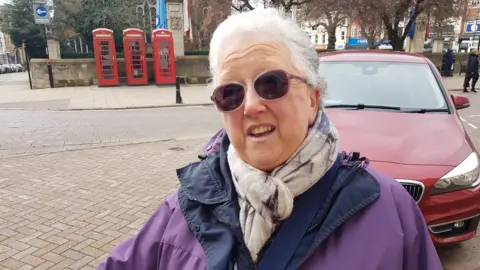
Northampton is not only competing with online retailers and Rushden Lakes, but larger towns nearby with a greater selection of shops.
Milton Keynes, for example, is a 15-minute train journey away and has a Marks and Spencer, House of Fraser and a John Lewis.
You might also be interested in
"Big towns and cities can attract the crowds and be a destination for a day out, while smaller centres [offer] convenience," says Kardi Somerfield, senior marketing lecturer at the University of Northampton.
"So mid-range towns are particularly and disproportionally affected by store closures."
 Leon Neal/Getty
Leon Neal/GettyStudent Halymah Agboola rarely ventures into Northampton's centre.
"It's probably about once a fortnight to look for clothes. There are much better deals and discounts for students online and it's just less hassle," says the 22-year-old.
"A lot of students I know are going into the centre regularly to pubs and clubs. But I'm not sure what else would attract young people into town and city centres."
Perhaps the answer lies in St Giles Street, which runs adjacent to Abington Street.
It features a range of small, independent businesses from barbers to restaurants and - despite a handful of empty units - feels altogether more prosperous.
Lisa Witham, 29, runs the Dreams Coffee Lounge with her sister, Nina Neophitou, 25. She says the key to the street's success is simple.
"There's a lot of lovely independent shops all offering different experiences for customers, rather than the generic High Street shops.
"The experience for the customer is important. Offer something a bit different that online and out-of-town retailers can't."
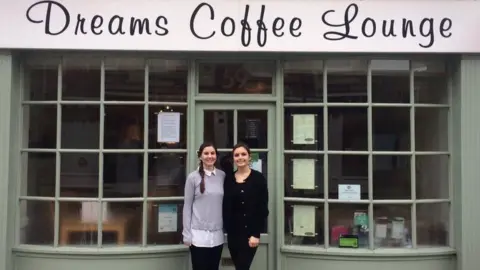 Lisa Witham
Lisa WithamSteve Ward and his wife Caroline run St Giles Cheese, which also sells locally produced gin.
"Abington Street is just the classic, dying High Street isn't it? You're losing all these big names, one after another," says Steve.
Northampton Borough Council has made efforts to revitalise the town centre. According to some, progress has been slow, but a new board has been created to tackle some of the the town's long-standing issues of shop closures and poor footfall.
The board, called Northampton Forward and comprising public and private-sector organisations, has already expressed an interest in bidding for a slice of the government's £620m Future High Streets Fund in order to improve areas including the Market Square and a section of Abington Street.
And after being awarded £215,000 in central government funding, the council has also created five new positions, including a specialist mental health worker, to help reduce rough sleeping.
"We know the town has some problems, particularly the centre which is suffering through a combination of factors," says council leader Jonathan Nunn.
"The primary aim of this new board is to ensure everyone is pulling in the same direction to address those issues and allow the town to live up to its promise."

A slew of new cafes and restaurants have breathed life into the town centre area and there has been a flurry of regeneration work around the newly designated Cultural Quarter.
It is home to the Royal and Derngate Theatre which recently kicked off the UK tour of Kinky Boots - a nod to the town's shoemaking heritage, based on the story of a struggling Northampton shoe factory.
Nearby, the town's museum, which is currently closed for a major refurbishment, is due to reopen next year. And the University of Northampton's new £330m campus, which opened in September, brought some 12,000 students and 2,000 staff to the area.
Signs of progress mean many businesses are cautiously optimistic about the future, with caveats.
"There needs to be more support from the council and landlords, making sure we get the right businesses in," says Lisa.
"There needs to be variety with the retail, with leisure options such as bowling or maybe an arcade. We have students nearby but they need an incentive to come into town.
"But the more empty units there are, the more difficult it is to attract new businesses. It's easy to get into a downward spiral."
